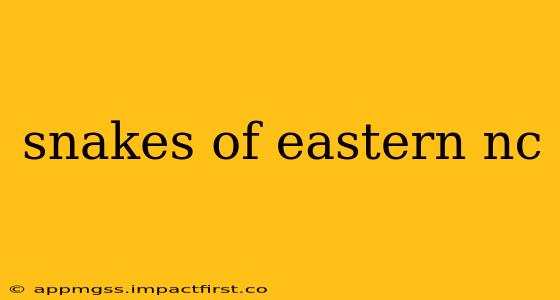Eastern North Carolina boasts a diverse range of snake species, from harmless garter snakes to venomous copperheads. Understanding these snakes is crucial for safety and appreciating the region's rich biodiversity. This guide explores the common snakes found in the area, addressing frequently asked questions and offering tips for safe coexistence.
What are the most common snakes in Eastern NC?
Eastern North Carolina's snake population is varied, but some species are more frequently encountered than others. These include:
-
Eastern Garter Snake (Thamnophis sirtalis sirtalis): A slender, non-venomous snake with three distinct stripes running down its back. They are commonly found near water sources.
-
Black Racer (Coluber constrictor priapus): A fast, agile, and non-venomous snake, typically black or dark brown. They are known for their speed and ability to climb.
-
Corn Snake (Pantherophis guttatus): Often kept as pets, these non-venomous snakes are relatively docile and display beautiful patterns. They can vary in color but are generally reddish-brown with darker blotches.
-
Copperhead (Agkistrodon contortrix): A venomous pit viper with a distinctive copper-colored head and hourglass-shaped markings on its body. Exercise caution if you encounter one.
-
Cottonmouth (Agkistrodon piscivorus): Also known as a water moccasin, this venomous pit viper is found near water sources. They are stout-bodied with dark, often black, coloration.
-
Eastern Hognose Snake (Heterodon platirhinos): A non-venomous snake known for its unique defensive behavior – it will flatten its head and hiss aggressively, sometimes even playing dead.
This list isn't exhaustive, but it covers many of the snakes you're most likely to see in Eastern NC.
Are there venomous snakes in Eastern NC?
Yes, Eastern North Carolina is home to several venomous snake species, most notably the copperhead and cottonmouth. While encounters are relatively rare, it's essential to be aware of their presence and take necessary precautions. Knowing how to identify venomous snakes is crucial for safety. The key features to look for include:
- Triangular-shaped head: Venomous snakes often have a distinct triangular head shape.
- Heat-sensing pits (pit vipers): Copperheads and cottonmouths have heat-sensing pits between their eyes and nostrils.
- Elliptical pupils: Most venomous snakes have elliptical pupils, unlike the round pupils of many non-venomous snakes.
- Hourglass markings (copperheads): Copperheads have characteristic hourglass-shaped markings along their bodies.
Remember, however, that the presence of these features doesn't always guarantee a snake is venomous. It's best to avoid handling any snake you encounter and maintain a safe distance.
What should I do if I see a snake in my yard?
The best course of action when encountering a snake in your yard is to leave it alone. Most snakes are harmless and play a beneficial role in controlling rodent populations. If you feel threatened or uncomfortable, you can try gently guiding it towards a less accessible area of your yard using a long-handled broom or shovel. Avoid direct contact.
If the snake is venomous or poses a significant threat, contact a licensed wildlife removal professional. Never attempt to handle or kill a venomous snake yourself.
How can I prevent snakes from entering my home?
Snakes are often attracted to areas with abundant food sources (like rodents) and shelter. Taking the following precautions can reduce the likelihood of snakes entering your home:
- Seal cracks and crevices: Inspect your home’s exterior for any gaps or openings where snakes could potentially enter and seal them.
- Remove debris: Keep your yard clear of debris, brush, and wood piles that could provide shelter for snakes.
- Control rodent populations: Regularly maintain your property and employ rodent control measures to remove food sources that attract snakes.
- Install screens: Use screens on windows and vents to keep snakes out.
Following these steps can significantly reduce the risk of snakes entering your home.
What is the best way to identify a snake in Eastern NC?
Accurate snake identification requires careful observation and ideally, a good field guide or reputable online resource featuring photographs and descriptions of Eastern NC snakes. Focus on physical characteristics like scale patterns, head shape, body size and color, and habitat. If you're uncertain, err on the side of caution and assume the snake may be venomous.
This guide provides a general overview of snakes in Eastern North Carolina. Remember, responsible coexistence involves respecting wildlife and understanding the importance of their role in the ecosystem. If you have any concerns about snake identification or removal, consulting a local wildlife expert is always recommended.
